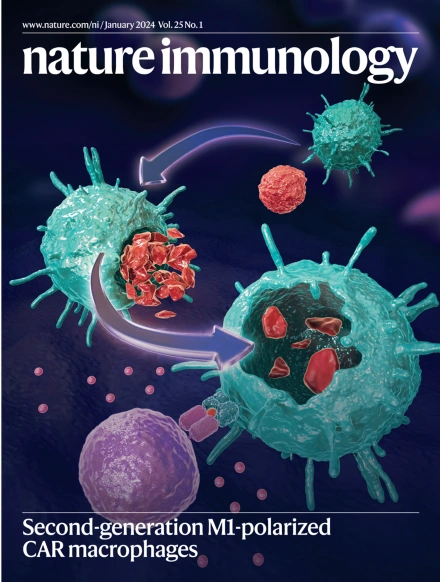Neurons protect against fibrosis
IF 27.6
1区 医学
Q1 IMMUNOLOGY
引用次数: 0
神经元防止纤维化
在感染和哮喘模型中,肺中的伤害感受器限制炎症,但它们是否参与肺纤维化的发展尚不清楚。在Immunity中,Hiroki等人发现TRPV1+伤害感受器在博莱霉素诱导的小鼠肺纤维化模型中控制炎症并具有保护作用。在博莱霉素诱导的肺纤维化前,TRPV1+感觉神经元的耗损导致存活降低,纤维化水平升高,TGFβ和血管活性肠肽(VIP)的产生增加。相反,如果肺泡巨噬细胞不能产生VIP,伤害感受器缺失小鼠的存活率会提高。痛觉感受器耗竭导致Siglec-F+中性粒细胞增加,这依赖于VIP和TGFβ。在肺中,VIP水平的升高诱导tgf - β的产生。在痛觉感受器缺失的PF小鼠中,可溶性中性粒细胞胞外陷阱(NETs)和产生net的siglece - f +中性粒细胞增加;如果用NET阻滞剂治疗小鼠,存活率会提高。阻断VIP或TGFβ均可减少肺内NET的形成。总之,作者认为肺伤害感受器调节炎症,加剧肺纤维化;痛觉感受器的缺失增加了肺泡巨噬细胞VIP的产生,从而诱导TGFβ的产生,并导致siglece - f +中性粒细胞和NET的形成增加。原参考文献:豁免https://doi.org/10.1016/j.immuni.2025.05.002 (2025)
本文章由计算机程序翻译,如有差异,请以英文原文为准。
求助全文
约1分钟内获得全文
求助全文
来源期刊

Nature Immunology
医学-免疫学
CiteScore
40.00
自引率
2.30%
发文量
248
审稿时长
4-8 weeks
期刊介绍:
Nature Immunology is a monthly journal that publishes the highest quality research in all areas of immunology. The editorial decisions are made by a team of full-time professional editors. The journal prioritizes work that provides translational and/or fundamental insight into the workings of the immune system. It covers a wide range of topics including innate immunity and inflammation, development, immune receptors, signaling and apoptosis, antigen presentation, gene regulation and recombination, cellular and systemic immunity, vaccines, immune tolerance, autoimmunity, tumor immunology, and microbial immunopathology. In addition to publishing significant original research, Nature Immunology also includes comments, News and Views, research highlights, matters arising from readers, and reviews of the literature. The journal serves as a major conduit of top-quality information for the immunology community.
 求助内容:
求助内容: 应助结果提醒方式:
应助结果提醒方式:


